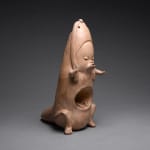Olmec Sculpture of a Fantastic Creature, 900 BCE - 500 CE
Terracotta
height 33 cm
height 13 in
height 13 in
PF.0248
Further images
The Olmecs are generally considered to be the ultimate ancestors of all subsequent Mesoamerican civilisations. Thriving between c. 1200 and 400 BC, their base was the tropical lowlands of south...
The Olmecs are generally considered to be the ultimate ancestors of all subsequent Mesoamerican civilisations. Thriving between c. 1200 and 400 BC, their base was the tropical lowlands of south central Mexico, an area characterized by swamps punctuated by low hill ridges and volcanoes. Here the Olmecs practiced advanced farming techniques and constructed many permanent settlements. Their influence, both cultural and political, extended far beyond their boundaries, and their ceramics enjoyed a particularly wide distribution. The exotic nature of Olmec designs became synonymous with elite status in other (predominantly highland) groups, with evidence for exchange of artefacts in both directions. Other than their art, they are credited with the foundations of writing systems (the loosely defined Epi-Olmec period, c. 500 BC), the first use of the zero – so instrumental in the Maya long count vigesimal calendrical system – and they also appear to have been the originators of the famous Mesoamerican ballgame so prevalent among later cultures in the region.
The art form for which the Olmecs are best known, the monumental stone heads weighing up to forty tons, are generally believed to depict kingly leaders or possibly ancestors. Other symbols abound in their stylistic repertoire, including several presumably religious symbols such as the feathered serpent and the rain spirit, which persisted in subsequent and related cultures until the middle ages. Comparatively little is known of their magico-religious world, although the clues that we have are tantalising. Technically, these include all non-secular items, of which there is a fascinating array. The best- known forms are jade and ceramic figures and celts that depict men, animals and fantastical beasts with both anthropomorphic and zoomorphic characteristics. Their size and general appearance suggests that they were domestically- or institutionally-based totems or divinities. The quality of production is astonishing, particularly if one considers the technology available, the early date of the pieces, and the dearth of earlier works upon which the Olmec sculptors could draw. Some pieces are highly stylised, while others demonstrate striking naturalism with deliberate expressionist interpretation of some facial features (notably down-turned mouths and slit eyes) that can be clearly seen in the current figure.
Enigmatic, magical, even disturbing, this unique sculpture touches a chord deep in the subconscious of every person who views it. How any individual reacts depends on personal experience--where one has been, what one knows and believes. It is impossible to be neutral or objective in describing it; the same features take on a myriad of meanings, the possiblities are infinite. Some have seen a Meso-American Jonah myth, a man struggling within a whale, the hollow space representing the stomach where he lives. Others see a shark-man, an alligator, an amphibious water spirit. Some believe it is a medical talisman designed to cure illness--ulcers or cancer. A costumed shaman or a demon of the underworld have also been suggested. Perhaps it is the very first creature ever to climb above the primeval morass and declare itself to be human. In the presence of this extraordinary object, one is intrigued, mystified, challenged, but never bored. It opens a path to the past we may never have considered before.
The art form for which the Olmecs are best known, the monumental stone heads weighing up to forty tons, are generally believed to depict kingly leaders or possibly ancestors. Other symbols abound in their stylistic repertoire, including several presumably religious symbols such as the feathered serpent and the rain spirit, which persisted in subsequent and related cultures until the middle ages. Comparatively little is known of their magico-religious world, although the clues that we have are tantalising. Technically, these include all non-secular items, of which there is a fascinating array. The best- known forms are jade and ceramic figures and celts that depict men, animals and fantastical beasts with both anthropomorphic and zoomorphic characteristics. Their size and general appearance suggests that they were domestically- or institutionally-based totems or divinities. The quality of production is astonishing, particularly if one considers the technology available, the early date of the pieces, and the dearth of earlier works upon which the Olmec sculptors could draw. Some pieces are highly stylised, while others demonstrate striking naturalism with deliberate expressionist interpretation of some facial features (notably down-turned mouths and slit eyes) that can be clearly seen in the current figure.
Enigmatic, magical, even disturbing, this unique sculpture touches a chord deep in the subconscious of every person who views it. How any individual reacts depends on personal experience--where one has been, what one knows and believes. It is impossible to be neutral or objective in describing it; the same features take on a myriad of meanings, the possiblities are infinite. Some have seen a Meso-American Jonah myth, a man struggling within a whale, the hollow space representing the stomach where he lives. Others see a shark-man, an alligator, an amphibious water spirit. Some believe it is a medical talisman designed to cure illness--ulcers or cancer. A costumed shaman or a demon of the underworld have also been suggested. Perhaps it is the very first creature ever to climb above the primeval morass and declare itself to be human. In the presence of this extraordinary object, one is intrigued, mystified, challenged, but never bored. It opens a path to the past we may never have considered before.







